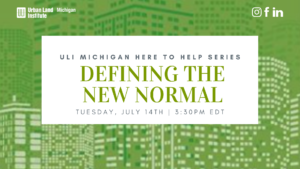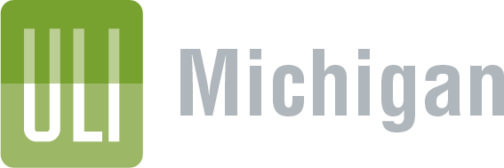Here to Help Series: Defining the New Normal

By: Victoria Comer and Corissa Green
Webinar Part 5 Recap
ULI Michigan Here to Help Webinar Series
Defining the New Normal
In Part 5 of ULI Michigan’s Here to Help Webinar Series, we talked about “Defining the New Normal”, life with COVID, and how we are starting to move forward from crisis. Our panelists explored changes in the workspace, cultural shifts, and the growing demand for vibrant public spaces. Our ALL-STAR lineup included: Mindy Lopus, Director of Collaborative Workspace at TechTown Detroit; Sam Hamburger, Vice President, Acquisitions & Leasing at Bedrock Detroit; Mark Miller, Managing Director of Planning and Design with Downtown Grand Rapids Inc.; Chris Hallendy, Chief Executive Officer at Resolute Building Intelligence; and Amy Warden, National Workplace Practice Manager at SmithGroup.
Below you will find resources from the webinar presentation and some of our key takeaways:
Click Here for the Full Slidedeck
Mindy Lopus – Director of Collaborative Workspace, TechTown Detroit was able to touch on how TechTown has been able to successfully reopen their doors and the steps they took to get there:
- Multi-step plan for reopening (re-entered the building on June 15)
- One-way direction hallways
- Temperature monitoring in several areas of the building
- Dedicated Zoom Conference Room
- Social Distancing throughout building
- Expanded Coworking space by including some of the previous dedicated event space to keep people about 10 feet apart
- Plexiglass barriers in between desks
- Upgrades to HVAC system
- Requiring masks inside of the building
- COVID supervisor that monitors for potential issues onsite
- Door system that monitors people in and out of the building
- No events or guests allowed
- Limited hours – Used to be available 24/7 and now have reduced hours Monday-Friday 9:00AM-5:00PM
- As a result, have reduced membership fees
- Turned small meeting rooms into individual offices
- Removed all fabric lined furniture with easy to clean substitutes throughout the building
Sam Hamburger, Vice President, Acquisitions and Leasing at Bedrock Detroit discussed with us the unique offerings Bedrock has been able to extend to their commercial tenants, including, rent relief, reopening packages, and driving customer traffic:
- Rent Relief Programs
- 2-3 month rent abatement for all commercial tenants
- End of May, initiated Phase 2 of Rent Relief Program
- 7% Variable rental structure for tenants who qualify through the end of the year
- Main focus is keeping small business tenants afloat
- Reopening packages
- Putting together playbooks for tenants who are reopening
- Clear and transparent signage
- Offering tenants access to their security deposits as a unique way to provide cash for unforeseen opening expenses, such as:
- PPE
- Outdoor furniture
- Plexiglas dividers, etc.
- Driving Customer Traffic
- Downtown Detroit is operating at a 5-10% occupancy to the normal 85,000 professionals who would have been downtown on any given day pre-COVID
- Providing extended outdoor space for retailers
- Promoting restaurants and small businesses
- Lowering the barrier for small businesses
- Using apps and technology to give consumers a tool to determine the safety of a space
- Working closely with Downtown Detroit Partnership
Mark Miller, Managing Director of Planning and Design, Downtown Grand Rapids Inc. described how Grand Rapid’s was able to become a first mover in expanding outdoor public spaces and what it took from the community to get there:
- Throughout Downtown Grand Rapids DGRI created “social zones”
- They worked with the city as an entity to deploy
- Created expanded outdoor seating for restaurants (provided 200 tables, 700 chairs and 150 concrete barriers)
- Ordered tables and chairs for the city 2-months before the City reopened
- Deployed materials with in less than 24-hours once they were given the oaky to reopen
- Closed off parts of streets to carve out designated seating areas
- Kept through movement
- Within days, business owners brought in their own landscaping, planters, umbrellas, string lights and created welcoming spaces for people
- Under constant change of space laws, being nimble and keeping open lines of communication with the City have been extremely important component during this process
- Downtown Grand Rapids Inc has a team that is making sure spaces stay clean with sanitation stations, cleaning the tables and chairs daily, and removing trash frequently
- Looking into the future, DGRI is considering:
- Reallocating under-utilized parking for public access spaces
- Driving patterns
- Improving business traffic
Chris Hallendy, CEO, Resolute Building Intelligence shared the importance of building intelligence, from pre-COVID being an afterthought to after-COVID becoming one of the most sought-after items in budget discussions:
- You can only improve what you can measure
- Data collection in buildings used to be nice to have but now it’s incredibly important in the fight against COVID and making people feel safe
- What does it mean to feel safe in a building now?
- Amount of air exchanges in a building
- Percentage of fresh air in the building
- Identifying the parts per million of CO2
- Tracking people and data
Amy Warden, Corporate Workplace Practice Manager, SmithGroup explored the future of design and how her company, as well as their clients, are strategically planning office/retail/commercial space post-COVID while preparing for the next pandemic:
- Design a better future is SmithGroup’s design slogan
- Returning to business as usual is a missed opportunity
- The pandemic put a spotlight on work flexibility
- Paradigm shift on where work can be done- staff crave workplace flexibility
- International Workplace Groups 2019 study stated 77% of global businesses have issued flexible workplace policies to obtain and retain top talent
- According to FlexJobs, 76% of workers say they would be more loyal to an employer who offered flexible workplace options
- Colliers recently published a study finding post-pandemic 70% of workers would like to continue working from home at least one-day per week
- Designing workplace can be a tool for retention, culture, brand and workspaces should be designed well for the people who work there
- Developing a workplace ecosystem, by navigating how and where workplace activities are being accomplished
- To accomplish successfully, companies really need to determine their why and main drivers
- Connectivity and collaboration
- Tools & technology
- Culture
- To accomplish successfully, companies really need to determine their why and main drivers
- Developing a workplace ecosystem, by navigating how and where workplace activities are being accomplished
Thank you for tuning in! We will have our next Here to Help Webinar event on Tuesday, August 4th at 3:30PM EDT: The Change in Supply Chain Management and How it is Affect Real Estate. Register Here.
